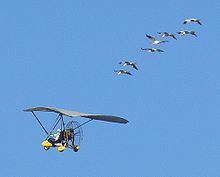
Human-guided migration or human-led migration is a method of restoring migratory routes of birds bred by humans for their reintroduction into the wild. [1] [2]
It is a technique especially used for endangered species in which the loss of individuals and territories has caused the disappearance of their migratory routes. To prevent their extinction, captive breeding has been needed, so their subsequent release into the wild requires teaching these routes to the juveniles. [2] [3]
Hand-reared juveniles have been imprinted on their adoptive parents, whom they follow. After a period of flight training and adaptation to the aircraft and its noise, the juveniles accompany their adoptive parents by flying to their wintering grounds. [1] [2]
This technique has been used in birds such as the northern bald ibis and the whooping crane, among other species. [3] [4] [5] [6]
See also
References
- ^ a b "Migration". Waldrappteam.
- ^ a b c Fritz, J.; Kramer, R.; Hoffmann, W.; Trobe, D.; Unsöld, M. (January 2017). "Back into the wild: establishing a migratory Northern bald ibis Geronticus eremita population in Europe". International Zoo Yearbook. 51 (1): 107–123. doi: 10.1111/izy.12163.
- ^ a b "Reintroduction. Siberian Crane". www.cms.int.
- ^ Voelkl, B.; Fritz, J. (2017-08-19). "Relation between travel strategy and social organization of migrating birds with special consideration of formation flight in the northern bald ibis". Philosophical Transactions of the Royal Society B: Biological Sciences. 372 (1727): 20160235. doi: 10.1098/rstb.2016.0235. ISSN 0962-8436. PMC 5498297. PMID 28673913.
- ^ "Parten desde Alemania los 35 polluelos de ibis camino de La Janda guiados por ultraligeros". Diario de Jerez (in Spanish). 2023-08-22.
- ^ Mooallem, Jon (2009-02-20). "Orchestrating the comeback of the whooping crane". The New York Times. ISSN 0362-4331.

Human-guided migration or human-led migration is a method of restoring migratory routes of birds bred by humans for their reintroduction into the wild. [1] [2]
It is a technique especially used for endangered species in which the loss of individuals and territories has caused the disappearance of their migratory routes. To prevent their extinction, captive breeding has been needed, so their subsequent release into the wild requires teaching these routes to the juveniles. [2] [3]
Hand-reared juveniles have been imprinted on their adoptive parents, whom they follow. After a period of flight training and adaptation to the aircraft and its noise, the juveniles accompany their adoptive parents by flying to their wintering grounds. [1] [2]
This technique has been used in birds such as the northern bald ibis and the whooping crane, among other species. [3] [4] [5] [6]
See also
References
- ^ a b "Migration". Waldrappteam.
- ^ a b c Fritz, J.; Kramer, R.; Hoffmann, W.; Trobe, D.; Unsöld, M. (January 2017). "Back into the wild: establishing a migratory Northern bald ibis Geronticus eremita population in Europe". International Zoo Yearbook. 51 (1): 107–123. doi: 10.1111/izy.12163.
- ^ a b "Reintroduction. Siberian Crane". www.cms.int.
- ^ Voelkl, B.; Fritz, J. (2017-08-19). "Relation between travel strategy and social organization of migrating birds with special consideration of formation flight in the northern bald ibis". Philosophical Transactions of the Royal Society B: Biological Sciences. 372 (1727): 20160235. doi: 10.1098/rstb.2016.0235. ISSN 0962-8436. PMC 5498297. PMID 28673913.
- ^ "Parten desde Alemania los 35 polluelos de ibis camino de La Janda guiados por ultraligeros". Diario de Jerez (in Spanish). 2023-08-22.
- ^ Mooallem, Jon (2009-02-20). "Orchestrating the comeback of the whooping crane". The New York Times. ISSN 0362-4331.